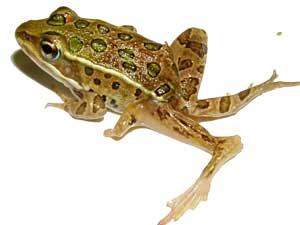|
Audio
Photos
Resources
|
St. Paul, Minn. — Pieter Johnson was an undergraduate student at Stanford University when he heard that a group of Minnesota school children had found a cluster of severely deformed frogs.
What he didn't know at the time was that within a year he would be examining deformed frogs discovered practically at his own California doorstep. The frogs came from two ponds within a half hour drive of his university campus.
Johnson began studying them and discovered something unusual. The ponds were located near another pond that contained no deformed frogs.
Johnson knew once he figured out what was unique about the pond without deformed frogs might explain what was causing the frog deformities in the other ponds.
"It had crayfish in it," says Johnson. "And what's different about crayfish is that they actually eat snails. Why are snails important? Well it turns out that snails are the key host in the parasite lifecycle."
|
"One of our main study sites is in the Twin Cities and that wetland has the highest level of parasite infection that we've recorded anywhere in the country. So I think this is still a very real problem."
- Pieter Johnson
|
The parasite Johnson refers to is a tiny flatworm called a trematode. It settles in the joints of young frogs and interferes with their limb development.
The parasite lives a fairly complicated existence, depending on lots of creatures, like birds and snails, to survive. For the parasite to reproduce, a bird has to eat an infected frog. Once inside the bird, the parasite releases eggs that end up in the bird's droppings. When those droppings fall in a pond, the eggs hatch into larvae. The larvae then search for snails to harbor them until they are mature enough to move into frogs and infect them and repeat the process all over again.
Johnson traveled the country to try to prove the link between parasites and deformed frogs. He visited six states and surveyed hundreds of ponds and wetlands. The parasite was present in every location where he found deformed frogs. To date more than 40 states have reported frog deformities.
So, what if anything has changed in recent years that might explain why the parasite is so widespread? Johnson believes that humans and their land-use practices have contributed.
He says heavy fertilizer use has created an ideal environment for the parasite to expand its range. And the more parasites, the more deformed frogs.
"With this trematode parasite in frogs what we've been finding is that nutrient pollution or eutrification, basically elevated levels of nitrogen and phosphorus in aquatic systems, can have a really strong promoting effect on the parasite."
Johnson says phosphorus and nitrogen promote aquatic plant growth, which then increases the number of snails in the water that can carry the parasite. Minnesota recently banned the use of phosphorus in lawn products, but the fertilizer is still used widely in agriculture and in some dishwasher soaps. And it takes a long time to break down in the soil; Johnson says anywhere from 20 to 100 years in some cases.
In the meantime, the parasite is not considered a threat to human health. But Johnson predicts it will continue to kill lots of frogs and he says those that do survive with their deformities won't reach sexual maturity. That's clearly bad news for creatures like birds, snakes and raccoons which depend on frogs for food, he says.
Beyond that, Johnson says he's not sure what other effects to expect.
"The fact remains that we continue to find these deformed frogs all over the place and particularly in Minnesota," says Johnson. "One of our main study sites is in the Twin Cities and that wetland has the highest level of parasite infection that we've recorded anywhere in the country and we've been to hundreds of sites now. So I think this is still a very real problem and one that we need to get more research on and really get to the bottom of."
Johnson says his research does not rule out that there may be many other factors contributing to amphibian limb deformities, including pesticide exposure and ozone damage.





